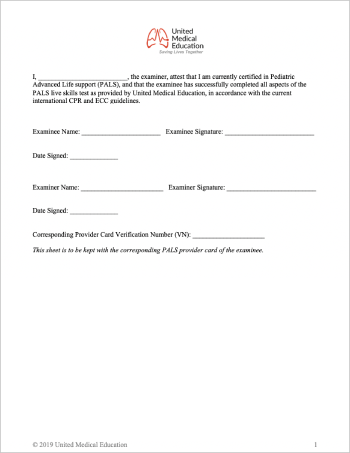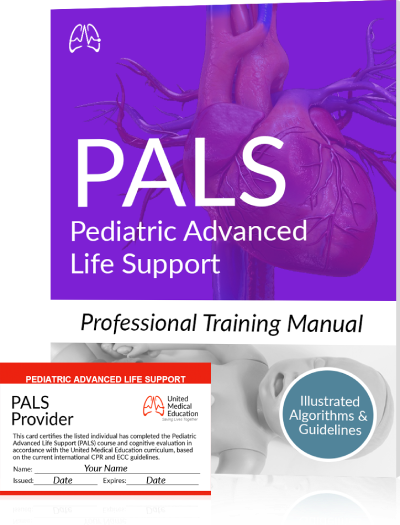What is the PALS Skills Session?
The Pediatric Advanced Life Support (PALS) skills session and checklist is an optional test that can accompany PALS certification. During the live skills session a student will be presented with a set of scenarios that involve pediatric patients in cardiopulmonary emergencies. The student will then be required to demonstrate proper decision making and mechanics in PALS with regards to current international CPR and ECC guidelines and standards.
PALS Examiner

The PALS skills session must be administered by a current certified PALS provider. Students will commonly recruit the services of their employer, manager, or acquaintance.
We highly recommend that each institution that requires a live hands-on evaluation to have an employee assigned to administering the skills session. This will help assure consistency and quality in the examination process.
If you don’t have access to an examiner using the options mentioned above, you can always use a non-affiliated professional skills session administrator.
*The PALS examiner should download and print the “Full PALS Skills Session PDF Document” below for testing purposes.
PALS Skills Checklist
The PALS skills checklist is used during the optional hands-on evaluation of an examinee. We provide complete instructions for the the test administrator and the student to help facilitate a consistent examination process. The test administrator will mark portions of the checklist as complete as he/she moves through the megacode scenarios. Once completed successfully by the student, the test administrator will sign the checklist. The student is then to adjoin the signed skills checklist with their PALS provider card as evidence of completion.

Full Exam Document
Here is the complete PALS skills session examination document for download. This is to be printed by the student or the test administrator. The examiner should read the instructions and follow along with the program as directed. We have designed the instructions and testing program in a way that is easy to perform for any current certified PALS provider.
DIRECTIONS for Skills Testing:
The examiner is to read the case scenarios aloud to the examinee. As the examinee works through each step in a scenario, the examiner is to mark each corresponding step on the checklist as Complete or Incomplete. Items marked as Complete are to be performed correctly without guidance. If the examinee were to need guidance through a step, the step must be marked as Incomplete and the skills test should be repeated. No additional guidance should be given to the examinee beyond the information provided in italics. Areas needing improvement should be reviewed before retesting. Take approximately 10 minutes to complete each scenario.
*Have a PALS provider with current certification administer the test.
*Randomly select one BLS scenario for testing, and one respiratory arrest or megacode scenario for testing.
BLS Scenarios and Checklists
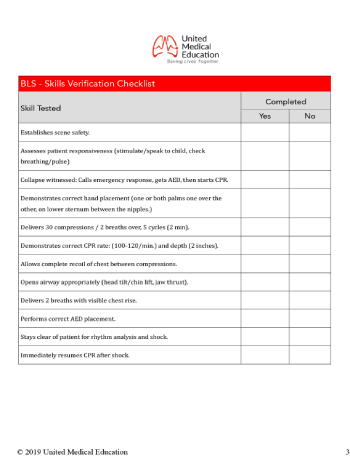
Airway Management Scenario
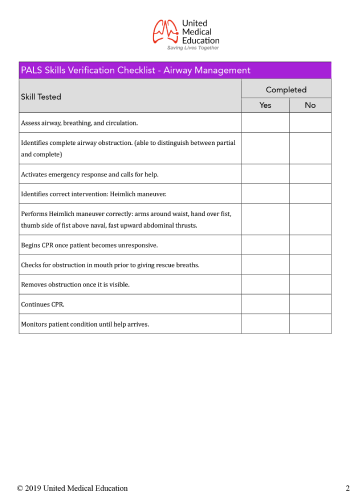
(Test administrator dialogue provided in italics)
You are watching a 2-year-old that is sitting at the table eating grapes. A few moments later you notice he is silent, and appears cyanotic.
1. Assesses airway, breathing, and circulation. (Patient unable to make noise, not breathing, pulse present)
2. Distinguishes between complete and partial airway obstruction.
3. Initiates emergency response and calls for help.
4. Recognizes need for intervention: Heimlich maneuver
5. Demonstrates Heimlich maneuver correctly by placing arms around the patient’s waist, having their hand over fist, with thumb side of fist above naval, and then provides fast upward abdominal thrusts.
You are performing the Heimlich maneuver but the child suddenly becomes unresponsive
6. Begins CPR immediately: single rescuer CPR 30:2 ratio
7. Prior to rescue breaths, checks for obstruction in patient’s mouth (After 2 cycles: You notice the grape is now visible in the mouth.)
8. Removes the obstruction from the patient’s mouth.
9. Continues CPR. (Patient now breathing spontaneously, strong pulse present).
10. Monitors patient condition until paramedics arrive.
| PALS Skills Verification Checklist – Airway Management | ||
|---|---|---|
| Skill Tested | Completed | |
| Yes | No | |
| Assess airway, breathing and circulation | ||
| Identifies complete airway obstruction. (Able to distinguish between partial and complete). | ||
| Activates emergency response and calls for help. | ||
| Identifies correct intervention: Heimlich maneuver. | ||
| Performs Heimlich maneuver correctly: arms around waist, hand over fist, thumb side of fist above naval, fast upward abdominal thrusts. | ||
| Begins CPR once patient becomes unresponsive. | ||
| Checks for obstruction in mouth prior to giving rescue breaths | ||
| Removes obstruction once it is visible. | ||
| Continues CPR. | ||
| Monitors patient condition until help arrives. | ||
Tachyarrhythmia Megacode Scenario
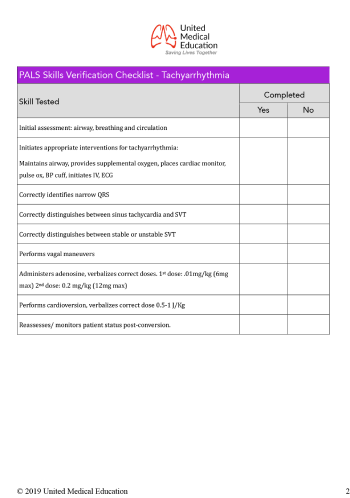
(Test administrator dialogue provided in italics)
An 11-year-old boy is brought into the ER for heart palpitations, shortness of breath and feeling fatigued.
1. Evaluates/assesses airway, breathing, and circulation. (Patient appears sluggish but answers questions, increased respiratory effort and nasal flaring, cool skin.)
2. Performs immediate interventions: maintain airway, place cardiac monitor, BP cuff, pulse ox, give supplemental oxygen, start IV, ECG.
Patient’s vital signs: HR- 210 bpm, BP- 84/62, RR- 30/min, spO2- 91%. The rhythm on the cardiac monitor shows the following:
3. Show examinee rhythm strip for SVT; Ask examinee to identify between wide or narrow QRS.
4. Have examinee identify between sinus tachycardia and SVT.
5. Have examinee identify between stable or unstable.
Patient is in SVT with poor perfusion. Cardioversion is not immediately available. What interventions will you attempt first?
6. Attempt vagal maneuvers first. (Vagal maneuvers unsuccessful)
7. Administers adenosine. Verbalizes correct initial dose- 0.1 mg/kg, max 6mg. (No change in patient condition after initial dose)
8. Administers second dose adenosine, verbalizes 0.2 mg/kg, max 12 mg. (Adenosine is ineffective)
9. Performs synchronized cardioversion. Verbalizes correct dose 0.5-1 J/Kg
Patient has converted back to normal sinus rhythm
10. Reassesses/ monitors patient cardiopulmonary status. Evaluate for signs of heart failure, ECG, orders lab tests, etc.
| PALS Skills Verification Checklist – Tachyarrhythmia Megacode | ||
|---|---|---|
| Skill Tested | Completed | |
| Yes | No | |
| Performs initial assessment: airway, breathing and circulation | ||
| Initiates appropriate interventions for tachyarrhythmia: Maintains airway, provides supplemental oxygen, places cardiac monitor, pulse ox, BP cuff, initiates IV, ECG | ||
| Correctly identifies narrow QRS | ||
| Correctly distinguishes between sinus tachycardia and SVT | ||
| Correctly distinguishes between stable or unstable SVT | ||
| Performs vagal maneuvers | ||
| Administers adenosine, verbalizes correct doses. 1st dose: .01mg/kg (6mg max) 2nd dose: 0.2 mg/kg (12mg max) | ||
| Performs cardioversion, verbalizes correct dose 0.5-1 J/Kg | ||
| Reassesses/ monitors patient status post-conversion. | ||
Bradyarrhythmia Megacode Scenario
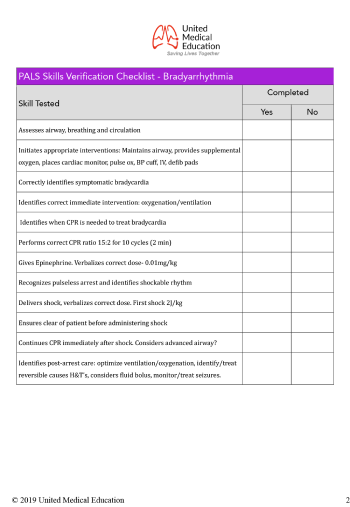
(Test administrator dialogue provided in italics)
Your paramedic team is called to the scene of a 7 yea-old girl having a seizure.
1. Assesses airway, breathing, and circulation. (Patient exhibits decreased respiratory effort, weak pulse, nonresponsive.)
2. Performs immediate interventions: maintain airway, give supplemental oxygen, place cardiac monitor, BP cuff, pulse ox, start IV, place defib pads.
Patient’s vital signs: HR- 44 bpm, BP- 84/52, RR- 8/min, spO2- 75%, Temp- 99.9F. Cardiac monitor shows following rhythm (show rhythm strip for sinus bradycardia)
3. Examinee correctly identifies cardiac rhythm and patient state of hypoxemia.
4. Identifies correct intervention: need for oxygenation/ventilation with non-rebreather mask.
Despite oxygenation and ventilation patient continues to have poor perfusion. New vitals: HR-58, spO2- 85%, BP- 84/56.
5. Identifies CPR needed to treat bradycardia, begins CPR (Bradycardia persists)
6. Performs correct CPR ratio 15:2 for 10 cycles (2 min)
7. Gives epinephrine. Verbalizes correct dose- 0.01mg/kg, every 3-5 min
At rhythm check there is no pulse, the monitor shows the following rhythm (show rhythm strip for VT)
8. Recognizes pulseless arrest and identifies shockable rhythm.
9. Delivers shock, verbalizes correct dose- first shock 2J/kg
10. Makes sure everyone is clear of patient.
11. Continues 2 min CPR, immediately after shock. (What intervention may you consider during CPR? Advanced airway)
At next rhythm check patient has achieved ROSC.
12. Identifies post-arrest care: optimize ventilation/oxygenation, identify/treat reversible causes H&T’s, considers fluid bolus, monitor/treat seizures.
| PALS Skills Verification Checklist – Bradyarrhythmia Megacode | ||
|---|---|---|
| Skill Tested | Completed | |
| Yes | No | |
| Performs initial assessment: airway, breathing and circulation | ||
| Initiates appropriate interventions: Maintains airway, provides supplemental oxygen, places cardiac monitor, pulse ox, BP cuff, IV, defib pads | ||
| Correctly identifies symptomatic bradycardia | ||
| Identifies correct immediate intervention: oxygenation/ventilation | ||
| Identifies when CPR is needed to treat bradycardia | ||
| Performs correct CPR ratio 15:2 for 10 cycles (2 min) | ||
| Gives Epinephrine. Verbalizes correct dose- 0.01mg/kg | ||
| Recognizes pulseless arrest and identifies shockable rhythm | ||
| Delivers shock, verbalizes correct dose. First shock 2J/kg | ||
| Ensures clear of patient before administering shock | ||
| Continues CPR immediately after shock. Considers advanced airway? | ||
| Identifies post-arrest care: optimize ventilation/oxygenation, identify/treat reversible causes H&T’s, considers fluid bolus, monitor/treat seizures. | ||
Megacode Rhythm Strips
1.

2.

3.

MEGACODE RHYTHM STRIPS KEY:
1. Supraventricular Tachycardia (SVT)
2. Ventricular Tachycardia – Monomorphic (VT)
3. Sinus Bradycardia
PALS Skills Session Certificate
